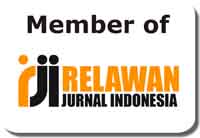Metadiscourse Markers in Scientific Journal Articles
Abstract
Keywords
Full Text:
PDFReferences
Abdi, R. (2002). Interpersonal metadiscourse: An indicator of interaction and identity. Discourse Studies, 4(2), 139–145. https://doi.org/10.1177/14614456020040020101
Akbarpour, M., & Sadeghoghli, H. (2015). The study on Ken Hyland’s interactional model in OUP publications. International Journal of Language and Linguistics, 3(4), 266–270. https://doi.org/10.11648/j.ijll.20150304.21
Alyousef, H. S. (2015). An investigation of metadiscourse features in international postgraduate business students’ texts: The use of interactive and interactional markers in tertiary multimodal finance texts. SAGE Open, 5(4), 1–10. https://doi.org/10.1177/2158244015610796
Andang, K., & Bram, B. (2018). Swear words and their implications for English language learning-teaching. LLT Journal: A Journal on Language and Language Teaching, 21(Suppl), 43–49.
Attarn, A. (2014). Study of metadiscourse in ESP articles: A comparison of English articles written by Iranian and English native speakers. International Journal of Learning, Teaching and Educational Research, 5(1), 63–71.
Aull, L. L., & Lancaster, Z. (2014). Linguistic markers of stance in early and advanced academic writing: A corpus-based comparison. In Written Communication (Vol. 31). https://doi.org/10.1177/0741088314527055
Blagojevic, S. (2004). Metadiscourse in academic prose: A contrastive study of academic articles written in English by English and Norwegian native speakers. Kalbų Studijos, (5), 60–67. Retrieved from https://www.kalbos.lt/zurnalai/05_numeris/08.pdf
Cao, F., & Hu, G. (2014). Interactive metadiscourse in research articles: A comparative study of paradigmatic and disciplinary influences. Journal of Pragmatics, 66, 15–31.
Crismore, A. & Farnsworth, R. (1990). Metadiscourse in popular and professional science discourse. In W. Nash (Ed.), The writing scholar: Studies in academic discourse (pp. 118–136). Newbury Park, CA: Sage Publications.
Crismore, A., Markkanen, R., & Steffensen, M. S. (1993). Metadiscourse in persuasive writing: A study of texts written by American and Finnish university students. In Written Communication (Vol. 10). https://doi.org/10.1177/0741088393010001002
Dafouz-Milne, E. (2003). Metadiscourse revisited: A contrastive study of persuasive writing through professional discourse. Estudios Ingleses de La Universidad Complutense, 11, 29–52. https://doi.org/10.5209/rev_EIUC.2003.v11.8792
Fairclough, N. (1995). Critical discourse analysis. London: Longman.
Febriyanti, R., Inderawati, R., & Fiftinova, F. (2018). Enhancing descriptive writing achievement by applying process approach through environmental observation. LLT Journal: A Journal on Language and Language Teaching, 21(Suppl), 21–32.
Gee, J.P., & Handford, M. (Eds.). (2012). The Routledge handbook of discourse analysis. New York: Routledge.
Gholami, M., Tajalli, G., & Shokrpour, N. (2014). An investigation of metadiscourse markers in English medical texts and their Persian translation based on Hyland’s model Mehrnaz. European Journal of English Language and Literature Studies, 2(2), 1–41.
Hadiyanti, K., & Widya, W. (2018). Analyzing the values and effects of powerpoint presentations. LLT Journal: A Journal on Language and Language Teaching, 21(Suppl), 87–95.
Harris, Z. (1952). Discourse analysis. Language, 28, 1–30.
Ho, V., & Li, C. (2018). The use of metadiscourse and persuasion: An analysis of first year university students’ timed argumentative essays. Journal of English for Academic Purposes, 33, 53–68. https://doi.org/10.1016/j.jeap.2018.02.001
Huh, M. H., & Lee, I. H. (2016). On the use of metadiscourse in EFL undergraduate student writing. English Teaching, 71(3), 99–120. https://doi.org/10.15858/engtea.71.3.201609.99
Hyland, K. & Tse, P. (2004). Metadiscourse in academic writing: A reappraisal. Applied Linguistics, 25(2), 156–177.
Hyland, K. (2005). Metadiscourse: Exploring interaction in writing. London: Continuum.
Indraswari, V., & Kuswandono, P. (2018). English teachers’ motivation and challenges in vocational high school in Yogyakarta. LLT Journal: A Journal on Language and Language Teaching, 21(Suppl), 96–104. Retrieved from https://e-journal.usd.ac.id/index.php/LLT/article/view/1197
Jorgensen, M., & Phillips, L. (2002). Discourse analysis as theory and method. London: Sage Publication.
Khedri, M., & Kritsis, K. (2018). Metadiscourse in applied linguistics and chemistry research article introductions. Journal of Research in Applied Linguistics, 9(2), 47–73.
Khedri, M., Ebrahimi, S. F. & Chan, S. H. (2013). An exploration of interactive metadiscourse markers in academic research article abstracts in two disciplines. Discourse Studies, 15(3), 319–331.
Kim, C.L., & Lim, J. M. H. (2013). Metadiscourse in English and Chinese research article introductions. Discourse Studies, 15(2), 129–146.
Kurniasari, M., & Mbato, C. (2018). Indonesian students’ language attitudes towards Indonesian and English through education and working frame. LLT Journal: A Journal on Language and Language Teaching, 21(Suppl), 69–86. Retrieved from https://e-journal.usd.ac.id/index.php/LLT/article/view/1184
Lee, J. J., & Subtirelu, N. C. (2015). Metadiscourse in the classroom: A comparative analysis of EAP lessons and university lectures. English for Specific Purposes, 37, 52–62.
Lee, J.J., & Casal, J. E. (2014). Metadiscourse in results and discussion chapters: A cross-linguistic analysis of English and Spanish thesis writers in engineering. System, 46, 39–54.
Lee, J.J., & Deakin, L. (2016). Interactions in L1 and L2 undergraduate student writing: Interactional metadiscourse in successful and less-successful argumentative essays. Journal of Second Language Writing, 33, 21–34.
Li, T., & Wharton, S. (2012). Metadiscourse repertoire of L1 Mandarin undergraduates writing in English: A cross-contextual, cross-disciplinary study. Journal of English for Academic Purposes, 11, 345–356.
Mina, K.G., & Biria, R. (2017). Exploring interactive and interactional metadiscourse markers in discussion sections of social and medical science articles. International Journal of Research in English Education, 2(4), 11–29.
Mirshamsi, A. & Allami, H. (2013). Metadiscourse markers in the discussion/conclusion section of Persian and English master’s theses. The Journal of Teaching Language Skills, 5(3), 23–40.
Mu, C., Zhang, L.J., Ehrich, J., & Hong, H. (2015). The use of metadiscourse for knowledge construction in Chinese and English research articles. Journal of English for Academic Purposes, 20, 135–148.
Noorian, M., & Biria, R. (2017). Interpersonal metadiscourse in persuasive journalism: A study of texts by American and Iranian EFL columnists. Journal of Modern Languages, 20(1), 64–79.
Paltridge, B. (2012). Discourse analysis: An introduction (2nd ed). New York: Bloomsbury.
Pratiwi, S., & Triprihatmini, V. (2018). Students’ perception on the use of video to assess performances in public speaking class. LLT Journal: A Journal on Language and Language Teaching, 21(Suppl), 33–42. Retrieved from https://e-journal.usd.ac.id/index.php/LLT/article/view/1177
Rezaie, M., & Lashkarian, A. (2015). The use of metadiscourse markers in TESOL and medical research articles. International Journal of English and Education, 4(4), 345–356.
Simin, S., & Tavangar, M. (2009). Metadiscourse knowledge and use in Iranian EFL writing. The Asian EFL Journal Quarterly, 11(1), 230–255.
Sultan, A. H. J. (2011). A contrastive study of metadiscourse in English and Arabic linguistics research articles. Acta Linguistica, 5, 28–41.
Tanjung, F. (2018). Language learning strategies in English as a foreign language classroom in Indonesian higher education context. LLT Journal: A Journal on Language and Language Teaching, 21(Suppl), 50–68. Retrieved from https://e-journal.usd.ac.id/index.php/LLT/article/view/966
Tannen, D., Hamilton, H.E., & Schiffrin, D. (Ed.). (2015). The handbook of discourse analysis. Oxford: John Wiley & Sons, Inc.
Thompson, P. (2013). Thesis and dissertation writing. In B. Paltridge & S. Starfield (Ed.), The handbook of English for specific purposes (pp. 283–299). West Essex: Wiley-Blackwell.
Uccelli, P., Dobbs, C. L., & Scott, J. (2013). Mastering academic language organization and stance in the persuasive writing of high school students. Written Communication, 30(1), 36–62.
Wang, L., & Zhang, Y. (2016). An analysis of metadiscourse in the abstracts of English academic papers. Global Journal of Human-Social Science, 16(9), 9–16.
Wulandari, A., & Ena, O. (2018). Using debate activities to develop Indonesian high school students’ speaking skills. LLT Journal: A Journal on Language and Language Teaching, 21(Suppl), 12–20. Retrieved from https://e-journal.usd.ac.id/index.php/LLT/article/view/1168
Yazdani, A. (2017). Comparing metadiscourse markers employed in English and Persian online headlines. International Journal of Research Studies in Language Learning, 6(4), 91–97. https://doi.org/10.5861/ijrsll.2016.1554
Yuksel, H.G., & Kavanoz, S. (2018). Dimension of experience: Metadiscourse in the texts of novice non-native, novice native and expert native speaker. Advances in Language and Literary Studies, 9(3), 104–112.
DOI: http://dx.doi.org/10.31332/lkw.v6i1.1528
Copyright (c) 2020 Veronica Esti Nugrahani, Barli Bram

This work is licensed under a Creative Commons Attribution-ShareAlike 4.0 International License.
Publisher:
UPT Pengembangan Bahasa, IAIN Kendari
Jln. Sultan Qaimuddin No. 17 Baruga, Kota Kendari, Sulawesi Tenggara
Website: upb.iainkendari.ac.id
Email: [email protected]



















